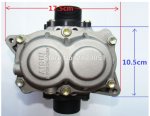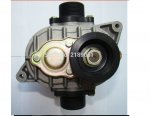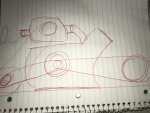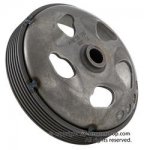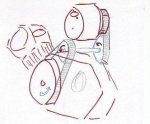bob58o
SuckSqueezeBangBlow
Maybe this will happen? Maybe it won't?
That is what this thread is for.
A place for me to gather some information and ideas.
https://www.aliexpress.com/item/Car...-Displacement-0-8-1-8L-model/32273549916.html
AISIN AMR300 mini Roots supercharger Compressor blower booster Turbocharger Kompressor Turbine Auto Car Snowmobile ATV 0.5-1.3L
Feel free to input anything you want, or feel free to ignore this altogether.
The plan (I should say idea, it's not a plan yet) is to supercharge a 212 Predator with an AISIN AMR300 Roots-Style Supercharger. It would be a Draw-Through Set-Up.
Air Filter > Carb > Pump > Cylinder Head Intake Port
I think I can use an unmodified carb on a Roots Style Draw Through Right?
Starting with what I know (or what I think I know)....
1.) The 300 in AMR300 means 300cc output per revolution.
2.) A 212cc 4 stroke engine uses 106cc of air per crank revolution if operating at 100% volumetric efficiency.
3.) A stock 212 Predator is ~8.5 Static Compression Ratio
4.) If ordering the pump with an A-type, V-Belt pulley, the pulley is ~3.27" (83mm)
5.) The AMR300 is reversible. (Spin it either direction)
I assume in order to make a 300cc / Revolution Pump output 106cc/Revolution I would need to UnderDrive the Pump 2.83:1 from the crank (3.27" Pulley on pump : 9.25" Pulley on "Crankshaft").
That would be operating at 14.7 psi (NO Boost).
If I want to double the amount of air the engine consumes, 212cc per crank revolution (424cc per complete 4 stroke cycle), then I UnderDrive the Pump 1.42:1 from the crank. (3.27" on Pump, 4.64" Pulley on "Crankshaft" (or with the pulley on a jackshaft spinning 1:1 with the crank).
At 212cc output/revolution, I MAY be operating at 29.4 PSI (14.7 PSI Boost). Pretty sure, but like I said - I only think I know the 5 things above.
Effective Compression Ratio for a Forced Induction Engine????
At first I thought if I double the PSI, I also double the Effective Compression Ratio (ECR). And I found this formula online.
http://www.theblowershop.com/wp-content/uploads/2015/08/Effective_Compression.pdf
ECR = ((BOOST + 14.7)/14.7) * CR
Meaning if running 14.7 PSI Boost, Then ECR = 2 * CR.
An 8.5 CR Engine would be 17:1 with 14.7 PSI Boost.
An 8.5 CR Engine with 29.4 PSI Boost (318cc per crank rev?) would have 25.5:1 ECR.
But then I came across this formula.
http://www.xcceleration.com/cr-boost 101.htm
" The problem is that most people use an incorrect formula that says that 14.7psi of boost on a 8.5:1 motor is a 17:1 ECR. So how in the world do people get away with this combination on pump gas? You can't even idle down the street on pump gas on a true 17:1 compression motor. Here's the real formula to use:
ECR = SQRT((BOOST PSI + 14.7)/14.7) * CR"
Meaning if running 14.7 PSI Boost, Then ECR = SQRT(2) * CR = 1.44 * CR
An 8.5:1 CR Engine with 14.7 PSI would be 12:1 ECR
And 8.5:1 CR Engine with 29.4 PSI boost would be 14.7:1 ECR
So which is it?
Does 14.7 PSI Boost make 12:1 ECR or 17:1 ECR on an 8.5:1 Compression Ratio Engine???
And 29.4 PSI Boost? 14.7:1 is very different than 25.5:1.
I'm ABOOT to try a little ideal gas law, but I've got P's, V's, n's, R's, and T's. But I don't have any squared terms?
Let's hear it.
Also, would a Draw Through set-up need a Bypass Valve or Blow off?
When the throttle is closed, a bypass that routes some of the output of the pump back to the input side (after the carb)? I don't think you need it with a draw-through, But I don't know? Maybe needed at idle? Or for starting?
Lots of ideas floating around right now. Don't want to lose focus yet.
That is what this thread is for.
A place for me to gather some information and ideas.
https://www.aliexpress.com/item/Car...-Displacement-0-8-1-8L-model/32273549916.html
AISIN AMR300 mini Roots supercharger Compressor blower booster Turbocharger Kompressor Turbine Auto Car Snowmobile ATV 0.5-1.3L
Feel free to input anything you want, or feel free to ignore this altogether.
The plan (I should say idea, it's not a plan yet) is to supercharge a 212 Predator with an AISIN AMR300 Roots-Style Supercharger. It would be a Draw-Through Set-Up.
Air Filter > Carb > Pump > Cylinder Head Intake Port
I think I can use an unmodified carb on a Roots Style Draw Through Right?
Starting with what I know (or what I think I know)....
1.) The 300 in AMR300 means 300cc output per revolution.
2.) A 212cc 4 stroke engine uses 106cc of air per crank revolution if operating at 100% volumetric efficiency.
3.) A stock 212 Predator is ~8.5 Static Compression Ratio
4.) If ordering the pump with an A-type, V-Belt pulley, the pulley is ~3.27" (83mm)
5.) The AMR300 is reversible. (Spin it either direction)
I assume in order to make a 300cc / Revolution Pump output 106cc/Revolution I would need to UnderDrive the Pump 2.83:1 from the crank (3.27" Pulley on pump : 9.25" Pulley on "Crankshaft").
That would be operating at 14.7 psi (NO Boost).
If I want to double the amount of air the engine consumes, 212cc per crank revolution (424cc per complete 4 stroke cycle), then I UnderDrive the Pump 1.42:1 from the crank. (3.27" on Pump, 4.64" Pulley on "Crankshaft" (or with the pulley on a jackshaft spinning 1:1 with the crank).
At 212cc output/revolution, I MAY be operating at 29.4 PSI (14.7 PSI Boost). Pretty sure, but like I said - I only think I know the 5 things above.
Effective Compression Ratio for a Forced Induction Engine????
At first I thought if I double the PSI, I also double the Effective Compression Ratio (ECR). And I found this formula online.
http://www.theblowershop.com/wp-content/uploads/2015/08/Effective_Compression.pdf
ECR = ((BOOST + 14.7)/14.7) * CR
Meaning if running 14.7 PSI Boost, Then ECR = 2 * CR.
An 8.5 CR Engine would be 17:1 with 14.7 PSI Boost.
An 8.5 CR Engine with 29.4 PSI Boost (318cc per crank rev?) would have 25.5:1 ECR.
But then I came across this formula.
http://www.xcceleration.com/cr-boost 101.htm
" The problem is that most people use an incorrect formula that says that 14.7psi of boost on a 8.5:1 motor is a 17:1 ECR. So how in the world do people get away with this combination on pump gas? You can't even idle down the street on pump gas on a true 17:1 compression motor. Here's the real formula to use:
ECR = SQRT((BOOST PSI + 14.7)/14.7) * CR"
Meaning if running 14.7 PSI Boost, Then ECR = SQRT(2) * CR = 1.44 * CR
An 8.5:1 CR Engine with 14.7 PSI would be 12:1 ECR
And 8.5:1 CR Engine with 29.4 PSI boost would be 14.7:1 ECR
So which is it?
Does 14.7 PSI Boost make 12:1 ECR or 17:1 ECR on an 8.5:1 Compression Ratio Engine???
And 29.4 PSI Boost? 14.7:1 is very different than 25.5:1.
I'm ABOOT to try a little ideal gas law, but I've got P's, V's, n's, R's, and T's. But I don't have any squared terms?
Let's hear it.
Also, would a Draw Through set-up need a Bypass Valve or Blow off?
When the throttle is closed, a bypass that routes some of the output of the pump back to the input side (after the carb)? I don't think you need it with a draw-through, But I don't know? Maybe needed at idle? Or for starting?
Lots of ideas floating around right now. Don't want to lose focus yet.

